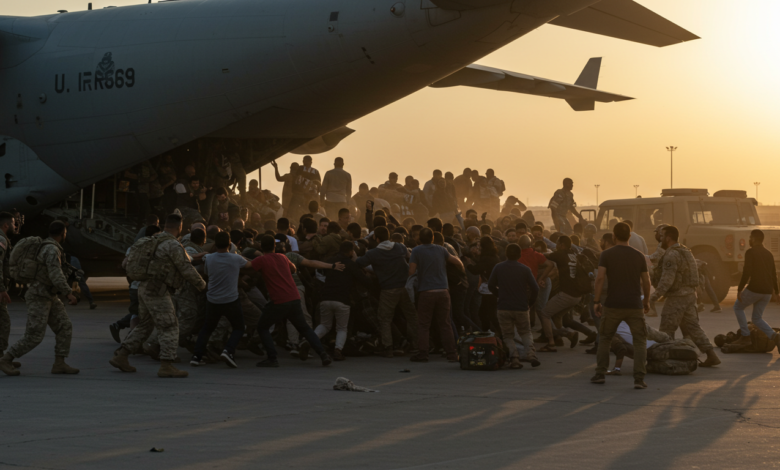U.S. Evacuates Personnel From Middle East: What to Know

Introduction
In June 2025, escalating tensions between Iran and Israel prompted the United States to initiate a significant evacuation of diplomatic personnel and military families from the Middle East. This unprecedented move underscores the volatility of the region and the U.S.’s commitment to safeguarding its citizens abroad. The evacuation, which affected personnel in Iran, Iraq, and Sudan, has far-reaching implications for U.S. foreign policy, regional stability, and international relations politico.com. You know about theglobespot, andaazdaily, openrendz and us. middle east evacuation also Buzzfeed.
Background: Rising Tensions in the Middle East
The catalyst for the U.S. evacuation was a series of military actions between Iran and Israel. Israel launched airstrikes targeting Iran’s nuclear facilities and military leadership, leading to significant casualties and infrastructural damage in Iran. In retaliation, Iran conducted missile attacks on Israeli civilian areas, resulting in both Iranian and Israeli casualties. The conflict prompted widespread concern over regional instability and the potential for broader military engagement.nypost.comnypost.com+2theguardian.com+2theguardian.com+2
President Donald Trump, attending the G7 summit in Canada, responded by ordering the evacuation of U.S. personnel from Iran and Iraq. He also issued a public warning for all residents in Tehran to evacuate immediately, citing the threat of Israeli airstrikes. The U.S. military began repositioning assets in the region, including the deployment of the USS Nimitz aircraft carrier, to bolster deterrence and provide support for evacuation operations.theguardian.com+2theguardian.com+2nypost.com+2
Evacuation Operations: A Multi-Nation Effort
Iran
The U.S. Embassy in Tehran had been closed for several years due to strained diplomatic relations. However, the U.S. maintained a diplomatic presence in the region through consulates and embassies in neighboring countries. As tensions escalated, the U.S. initiated contingency plans to evacuate personnel from these facilities.
Evacuation teams coordinated with host nations to facilitate the safe departure of American diplomats and their families. Specialized military units were deployed to assist in the evacuation process, ensuring the protection of personnel and the secure transport of sensitive materials.
Iraq
In Iraq, U.S. diplomats were ordered to leave the embassy in Baghdad and the consulate in Erbil due to unspecified security threats. The decision was made following intelligence reports indicating potential attacks by Iranian-backed militias targeting American facilities. The State Department implemented an “ordered departure,” allowing non-essential personnel to evacuate while maintaining essential diplomatic functions.politico.com+1cnn.com+1
Approximately 2,500 U.S. troops remained in Iraq, primarily stationed at the Al-Assad air base. These forces were tasked with securing American interests and supporting evacuation operations. The U.S. military also conducted airlifts to relocate personnel and assets to safer locations within the region.politico.com
Sudan
In Sudan, the U.S. Embassy in Khartoum was temporarily closed due to ongoing civil unrest and escalating violence between rival military factions. The U.S. military executed a swift and precise evacuation operation, utilizing helicopters to extract embassy staff and their families. The operation was completed in less than an hour, with no reported casualties. Evacuated personnel were transported to Ethiopia, where they were provided with temporary accommodations and support.apnews.com+1washingtonpost.com+1aljazeera.com
International Reactions and Diplomatic Implications
The U.S. evacuation prompted varied reactions from the international community. European leaders expressed concern over the potential for a broader conflict and called for renewed diplomatic efforts to de-escalate tensions between Iran and Israel. The United Nations issued statements urging restraint and emphasizing the importance of protecting civilian lives.theguardian.com+1politico.com+1
Iran condemned the U.S. evacuation as an act of aggression and interference in regional affairs. The Iranian government threatened to withdraw from the Nuclear Non-Proliferation Treaty and vowed to retaliate against any perceived U.S. involvement in Israeli military actions. Diplomatic channels remained open, but the situation remained volatile.theguardian.com
In the United States, the evacuation was met with bipartisan support for the safety of American personnel. However, lawmakers expressed concerns about the potential for increased military involvement in the region and the long-term implications for U.S. foreign policy. Discussions centered on balancing national security interests with diplomatic engagement and regional stability.
Historical Context: Precedents in U.S. Evacuation Operations
U.S. evacuations from the Middle East are not unprecedented. In 1991, during the Somali Civil War, the U.S. conducted Operation Eastern Exit to evacuate embassy personnel from Mogadishu. The operation involved U.S. Marines and Navy SEALs, successfully extracting diplomats and civilians from the conflict zone.en.wikipedia.org+1en.wikipedia.org+1
Similarly, in 1997, Operation Silver Wake was executed to evacuate American citizens from Albania amid civil unrest. U.S. Marines secured the embassy and facilitated the safe departure of personnel and third-country nationals.apnews.com+4en.wikipedia.org+4washingtonpost.com+4politico.com+3en.wikipedia.org+3en.wikipedia.org+3
These operations highlight the U.S. military’s capability to conduct complex evacuation missions in challenging environments, ensuring the protection of American citizens and diplomatic assets.
Strategic Considerations and Future Outlook
The U.S. evacuation from the Middle East reflects a strategic recalibration in response to evolving threats and regional dynamics. While the immediate priority was the safety of American personnel, the broader implications for U.S. foreign policy are significant.
The evacuation underscores the necessity for robust contingency planning and rapid-response capabilities to address unforeseen crises. It also emphasizes the importance of maintaining diplomatic channels and international partnerships to mitigate conflicts and promote stability.
Looking forward, the United States faces the challenge of navigating complex geopolitical landscapes, balancing national security interests with diplomatic engagement, and fostering regional cooperation to address underlying issues contributing to instability.



